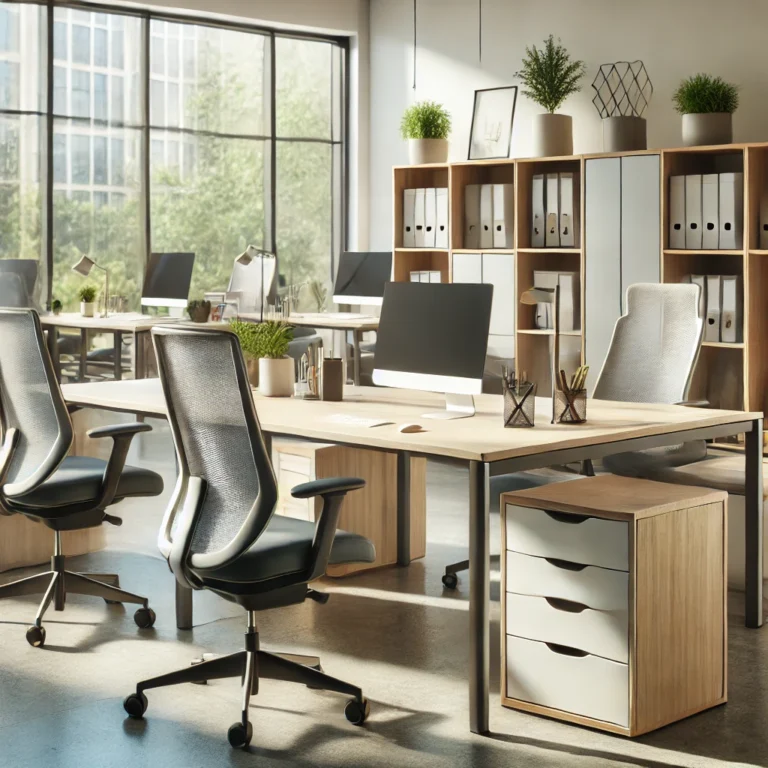Investing in preowned office furniture is a cost-effective and sustainable choice for businesses of all sizes. However, to maximize your investment, it’s crucial to evaluate several factors before making a purchase. This comprehensive guide will walk you through everything you need to check when buying secondhand office furniture, ensuring you make an informed decision.

Cost Savings
Purchasing preowned office furniture can save businesses up to 70% compared to buying new, freeing up budget for other priorities.
Sustainability Benefits
Choosing secondhand furniture helps reduce waste and promotes environmental sustainability, making your business eco-friendlier.
Immediate Availability
Unlike new furniture, which often requires waiting for production and shipping, preowned furniture is typically ready for immediate use.

Key Considerations Before Buying Preowned Office Furniture
1. Condition and Quality
Inspect for Damage
Check for visible damage like scratches, dents, or wobbly parts. Ensure the furniture is structurally sound and functional.
Test for Wear and Tear
Examine upholstery for stains or tears and assess mechanisms like chair recliners or drawer sliders.
2. Brand and Build Quality
Research Reputable Brands
High-quality brands often offer durable products that maintain value and usability over time.
Material Check
Look for sturdy materials like solid wood or metal for desks and chairs. Avoid flimsy materials prone to breakage.
3. Ergonomics
Prioritize Comfort
Ensure chairs offer proper lumbar support and adjustable features. Desks should accommodate ergonomic setups for monitors and keyboards.
Employee Needs
Consider the specific needs of your employees, especially if they’ll be using the furniture for extended periods.
4. Measurements and Space Planning
Measure Your Office Space
Bring accurate measurements of your office area to ensure the furniture will fit without overcrowding.
Plan the Layout
Sketch a layout plan to visualize how the furniture will fit into the available space.
5. Price and Budget
Compare Prices
Research market prices for similar items to ensure you’re getting a fair deal.
Set a Budget
Stick to a budget to avoid overspending, factoring in any refurbishing costs if needed.
6. Seller Reputation
Choose Trusted Sellers
Buy from reputable dealers or platforms specializing in preowned office furniture.
Check Reviews
Look for online reviews or testimonials to gauge the seller’s credibility and service quality.
7. Return Policy and Warranty
Ask About Returns
Ensure the seller offers a reasonable return policy in case the furniture doesn’t meet expectations.
Warranty Options
Some sellers provide limited warranties even for secondhand items; prioritize these for added peace of mind.

Common Mistakes to Avoid
Skipping Measurements
Failing to measure your office space can lead to purchasing furniture that doesn’t fit.
Ignoring Ergonomics
Choosing furniture solely based on price or appearance can result in discomfort and decreased productivity.
Overlooking Seller Reputation
Buying from unverified sellers increases the risk of receiving damaged or substandard furniture.
Purchasing preowned office furniture is a savvy choice for businesses seeking cost-effective, sustainable solutions. By focusing on quality, ergonomics, and seller credibility, you can make confident decisions that benefit your office environment. Use this guide to navigate the buying process and create a workspace that balances functionality, comfort, and style.
FAQs
1. Is preowned office furniture worth it? Yes, it’s a cost-effective and eco-friendly option, provided you assess quality and condition thoroughly.
2. Where can I buy preowned office furniture? Trusted sources include online marketplaces, furniture liquidators, and secondhand office supply stores.
3. How do I ensure the furniture fits my office space? Measure your office area accurately and sketch a layout plan before shopping.
4. Can I return preowned furniture? Return policies vary by seller, so confirm the terms before purchasing.
5. How do I clean used office furniture? Use appropriate cleaning agents for the material and disinfect surfaces to ensure hygiene.


